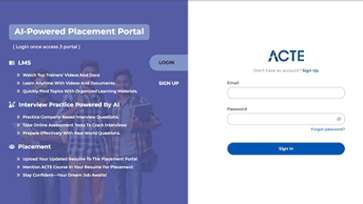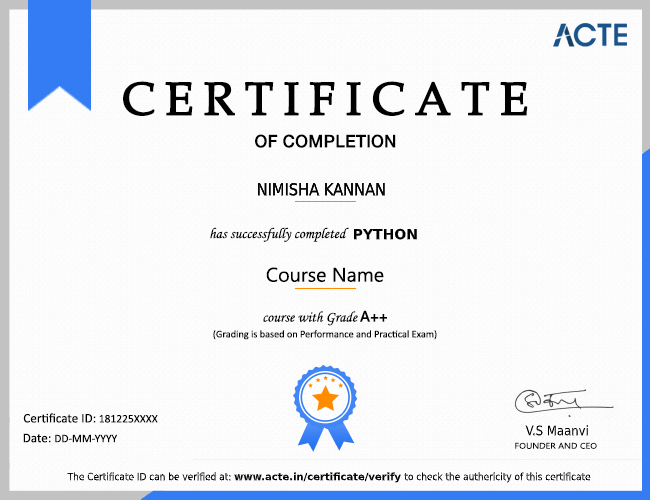This Guntur Business Analytics certification course teaches you the fundamentals of data analysis and statistics to help you make data-driven decisions. This course introduces you to Power BI and delves into statistical concepts to help you develop insights from available data and present your findings using executive-level dashboards.
Business Analytics with Excel is a great course for both beginners and experienced professionals who are new to or have recently entered the analytics field. This Business Analytics certification course will benefit IT developers and testers, data analysts, junior data scientists, analytics professionals, BI and reporting professionals, project managers, students, and professionals working with data in any industry.
Additional Info
Introduction:
This course introduces students to the science of business analytics while also emphasising the creative application of numbers in the digital realm. The goal is to provide businesses and managers with the foundation required to apply data analytics to real-world challenges that they face on a daily basis in their professional lives. Students will learn to select the best analytic tool for their specific needs, to collect, analyse, and visualise data in valid and reliable ways, and to use data to make decisions for their agencies, organisations, or clients. By leveraging data, organisations can use business analytics to make better, more informed decisions.
Data is an extremely valuable resource. However, developing a data-driven strategy is impossible without research. This course is an introductory course to analytics that lays the groundwork in an easy-to-understand and engaging manner. John David Ariansen, a data expert, explains why data is so powerful, what insights are truly valuable, and how to use common analysis tools and techniques. Furthermore, John David delves into data source maps, database management, and the various data sources that may be encountered. You should be able to collect, track, and analyse a wide range of data by the end of the course, including sales, marketing, and psychographic metrics.
Who is eligible to begin:
What is the role of a Business Analyst?
By driving the organisation toward efficiency and profitability, a Business Analyst bridges the gap between business and information technology. In order to meet business needs, they are primarily responsible for planning and monitoring, eliciting requirements, analysing functional and technical requirements, and communicating with various stakeholders.
How do I enrol in the Business Analyst Training programme?
You can register for this Business Analyst Training Program on our website and pay online using any of the methods listed below:
- MasterCard Credit or debit card from Visa.
- American Express Diner's Club.
- PayPal.
What steps should one take to become a business analyst?
A business analyst must be well-versed in both business and information technology. A domain expert, developer, or quality assurance specialist can all start their careers. They can conduct business analysis by gathering, analysing, and documenting requirements, as well as user testing and other tasks. The Business Analyst Training programme at Simplilearn will provide you with a solid foundation in business analysis.
What opportunities exist for business analysts?
With the market being disrupted by technologies such as artificial intelligence and machine learning, the demand for business analysts is greater than ever. Organizations rely on qualified business analysts for best practises advice and to stay competitive in the future. In summary, business analysts have a bright future.
Business Analytics Certification:
- Despite the fact that business analysis in Guntur is a relatively new discipline in IT, a few organisations already offer certifications to help you boost your resume and demonstrate your value as an analyst.
- Each organisation, such as the IIBA, IQBBA, IREB, and PMI, offers its own tailored business analysis certification.
Here are a few examples:
- The International Institute of Business Analysis awards the IIBA Entry Certificate in Business Analysis (ECBA).
- Certification for IIBA Competency in Business Analysis (CCBA).
- IIBA (International Institute of Business Analysis) Certified Business Analyst (CBAP).
- The IIBA's Agile Analysis Certification (AAC).
- Foundation Level Business Analyst Certification from IQBBA (CFLBA).
- The IREB has certified him as a Professional in Requirements Engineering (CPRE).
- Professional in Business Analysis, PMI (PBA).
Responsibilities and Roles:
- Business analysts use real-time user data and analytics programmes to identify user trends, successful functions, and potential user adoption issues with the applications.
- As data becomes more valuable to organisations, business analysts become more valuable.
- "One of the key values in the concept of the BA transitioning into being a product owner, as the entire line between IT and digital, software development and business shifts," says Kelly Emo, director of product and solutions marketing for application lifecycle and quality at HPE Software.
- Given the position's expanding list of responsibilities, some organisations, according to Hammond, have created product manager positions that work with BAs or have teams of BAs reporting to them.
- Similarly, the expansion of software development and its faster, iterative pace has shifted the timing of the BA's involvement in a given development project.
- A BA is more heavily involved at the front end of a traditional waterfall development environment, gathering, analysing, and prioritising user requirements before handing them off to developers and moving on to the next software development project.
- Meanwhile, on agile projects, business analysts typically stick with the project through implementation and even multiple releases.
- Organizations frequently assign BAs to multiple projects at once if they are small enough, or a BA to a single project if it is complex.
- According to Hammond, organisations also assign multiple BAs to very large software development projects.
- Emo claims that organisations are less likely to assign BAs to development work on new types of applications such as mobile marketing apps and apps for temporary sales promotions "because they're operating very lean or doing DevOps."
- “In continuous delivery mode, everything happens very quickly, and it is data-driven rather than [driven by] lengthy requirement documents.
- What I see today, particularly in digital first applications such as digital e-commerce, is the absence of the traditional business analyst.”
Training in Business Analytics in Guntur:
- The big data landscape has shifted dramatically, making it difficult for professionals to prioritise their development efforts.
- Regardless of the changing nature of the field, there are a few core business analytics skills that serve as the foundation of any successful business analytics career.
A fantastic business analytics professional could be described as follows:
A good communicator:
- The ability to present findings in a clear and concise manner is critical for ensuring that all stakeholders understand insights and can implement recommendations.
- Analysts must be able to tell a storey using data and must have strong writing and presentation skills.
Inquisitive:
- People working in this field should be naturally curious and motivated to learn more and figure out how things fit together.
- Even as analysts advance to management positions, it is critical to stay up to date on industry trends and changes.
A problem solver with imagination:
- Analytics professionals use logical reasoning, predictive analytics, and statistics to make recommendations that solve problems and propel a company forward.
- Being a natural problem solver is advantageous in a profession that seeks to transform data into solutions.
A critical thinker is someone who thinks critically:
- Business analytics professionals must consider not only the implications of the data they collect, but also the data they should collect in the first place.
- They are expected to analyse and highlight only relevant data for decision-making.
A visualiser is defined as:
- Data that is disorganised benefits no one.
- To create value from data, analytics professionals must be able to translate and visualise it in a concise and accurate manner that is easy to digest.
Detail-oriented and big-picture thinker:
- While business analytics professionals must be able to work with complex data, they must also understand how their recommendations will affect the bottom line of a company.
- It is pointless to have access to vast amounts of data if you do not understand how to use it to analyse and improve tactics, processes, and strategies.
Advantages:
1. Better-Informed Decision-Making:
- When it comes to making critical strategic decisions, business analytics can be a useful tool.
- Uber used prescriptive analytics to determine whether the new version of its Customer Obsession Ticket Assistant (COTA), a tool that uses machine learning and natural language processing to help agents improve their speed and accuracy when responding to support tickets, would be more effective than the previous version when it upgraded it in early 2018.
- Through A/B testing—a method of comparing the outcomes of two different options—the company was able to determine that the updated product resulted in faster service, more accurate resolution recommendations, and higher customer satisfaction scores.
- These breakthroughs not only accelerated Uber's ticket resolution process, but also saved the company millions of dollars.
2. Increased Profitability:
- Companies that embrace data and analytics initiatives can benefit financially significantly.
- According to McKinsey research, organisations that invest in big data see a 6% average increase in profits, which rises to 9% for five-year investments.
- In line with this trend, a recent BARC study discovered that businesses that can quantify their data analysis gains report an average 8% increase in revenues and a 10% decrease in costs.
- These findings show the clear financial payoff that can result from a strong business analysis strategy, which many companies can benefit from as the big data and analytics market grows.
- Data Science Bootcamp is related.
3. Enhanced Operational Efficiency:
- In addition to financial gains, analytics can be used to improve business operations.
- Many businesses are now using predictive analytics to anticipate maintenance and operational issues before they become larger problems, according to a recent KPMG report on emerging infrastructure trends.
- According to one surveyed mobile network operator, data is used to predict outages seven days in advance.
- Armed with this knowledge, the company can prevent outages by better timing maintenance, allowing it to not only save on operational costs but also ensure that assets perform optimally.
Business Analytics Course Career Path:
- Moving up the corporate ladder isn't the only way to advance. Lateral movements are possible. We can move from one position to another on the same level. These moves expose you to a wide range of experiences while also allowing you to grow and learn new skills.
- The traditional path of advancing to higher-level positions is also included in career advancement. This can range from business analyst to senior business analyst to business architect. Each stage will require the development of new skills as well as the ability to broaden your sphere of influence.
- To add more value to your organisation, you will most likely need to shift your thinking from tactical to strategic. Moving for a better job may necessitate relocating. You may need to relocate outside of your company or to a different facility within your organisation to explore different career opportunities.
- Be cautious if you don't want to be perceived as a job hopper. You want to be in the role for an extended period of time so that you can develop good skills and foundational practises. Typically, this takes between 18 months and two years. However, if you can apply your BA skills and techniques, you will almost certainly be able to accelerate your growth and career trajectory.
- Investigating your current position may also be a part of your career development. Examine the boundaries and parameters of your role, as well as those of related roles. You may have the opportunity to work with and explore roles such as project manager, product owner, and user experience designer as a business analyst.
- Working closely with people in these roles gives you the opportunity to pick up some of their techniques, skills, and practises. This allows you to expand and improve your skill set.
- People frequently fail to recognise that true growth necessitates realignment. This could imply leaving your current position to pursue a new one.
- A lateral move to senior project manager, for example, may not be possible if you are a senior business analyst who wants to explore project management. You may have to begin at the bottom of that role.
- Finally, career advancement may include enrichment opportunities. This entails staying within your role and honing the fundamental skills that distinguish you. This could imply honing your elicitation techniques, communication skills, facilitation, and influence as a Business Analyst.
- Your professional life may appear to have peaks and valleys, and even plateaus at times. Those plateaus provide opportunities for growth. a method for you to hone your foundational practise skills Consider it a launching pad from which to launch yourself to a higher level.
Payscale:
1. A Business Analyst can expect to earn around 3.6 lakhs per year as a new hire.
2. On the other hand, someone with more than a year of experience can expect to earn around 5.3 lakhs per year.
3. The highest salary for a Business Analyst in India is around 16 lakhs per year.
4. This salary, on the other hand, is directly proportional to the experience you bring with you.































